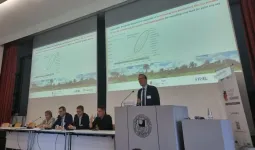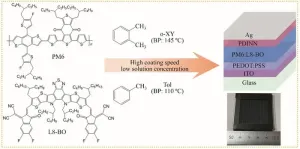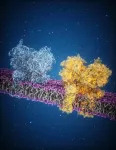(Press-News.org) Fruits and plant extracts contain bioactive compounds that can help treat or prevent diseases. To characterize and understand their mechanism of action, researchers from universities and research institutions in Brazil and Germany have conducted independent but complementary studies.
Some of the results were presented at a lecture session on the future of food and nutrition research on March 25th during FAPESP Week Germany at the Free University of Berlin.
According to Ulrich Dobrindt, a professor at the University of Munich in Germany, medicinal plants contain different types of phytochemicals (natural chemical substances) that neutralize bacterial infections in different ways, thereby boosting the host’s defenses. For this reason, there is growing interest in using extracts from these plants to treat and prevent urinary tract infections, one of the most common infections worldwide, which are currently treated with antibiotics.
“Although their anti-inflammatory, antipyretic and analgesic effects are well known, the active compounds of these plants – such as flavonoids, alkaloids and terpenoids – and their mechanisms of action on pathogen cells have yet to be characterized. Some are antibacterial, but many don’t have this effect,” said the researcher.
In order to further their understanding, German scientists have developed infection models to study the effects of plant extracts on the innate immune response and on the epigenetic regulation of gene expression (biochemical processes that activate and deactivate genes). In bladder cells, for example, they are studying the effect of traditional plants with urological activity, according to the German pharmacopoeia.
In collaboration with researchers at the Federal University of Minas Gerais (UFMG) in Brazil, it was found that some aqueous plant extracts (from species such as Solidago gigantea and Equiseti herba) significantly reduced the adhesion and survival of Escherichia coli in human bladder epithelial cells.
“We observed a drastic reduction in the adhesion and proliferation of this bacterium in bladder cells,” said Ulrich.
Fruit fibers
In Brazil, a group associated with the Food Research Center (FoRC) – one of FAPESP’s Research, Innovation and Dissemination Centers (RIDCs) – has focused on the technological prospection and evaluation of the biological effects on humans of non-digestible water-soluble polysaccharides (bioactive polysaccharides), such as pectins.
Found in papaya, passion fruit and citrus fruits, pectins make up a large portion of the fiber in these fruits and have been linked to a reduction in chronic non-communicable diseases.
However, some of the challenges in extracting these compounds from fruits such as papaya are that they ripen very quickly, resulting in softening of the pulp and chemical modification of the structures of its pectins, which are linked to biological effects such as modulation of the gut microbiota.
“During fruit ripening, enzymes are expressed that modify the structure of the pectins, reducing their beneficial biological effects. Passion fruit and citrus pectins, on the other hand, must be chemically modified in order to present beneficial activities in the intestine,” João Paulo Fabi, professor at the School of Pharmaceutical Sciences of the University of São Paulo (FCF-USP) and coordinator of the project, told Agência FAPESP.
To do this, the Brazilian researchers developed techniques to extract pectin from the albedo of oranges and passion fruit – the white part between the peel and the pulp that is normally discarded when the fruit is processed to make juice – and to modify it in the laboratory to reduce its molecular complexity in order to increase its biological activity.
The development resulted in a patent for the process of extracting pectin from fleshy fruits such as papaya and chayote. A second patent covering the modification of pectin from passion fruit by-products is in the process of being filed.
“We already have a prototype for extracting and modifying these pectins on a laboratory scale. The idea is to obtain a product, such as a flour rich in modified pectin, that could be consumed as a supplement or food ingredient,” said Fabi.
In partnership with other groups, the researchers conducted animal studies to demonstrate the correlation between modified pectins and increased biological activity.
“These preclinical studies can serve as a basis for the development of clinical trials [with modified pectins] as adjuvants to chemotherapy treatment of colon cancer or even as beneficial modulators of the intestinal microbiota,” the researcher said.
More information about FAPESP Week Germany can be found at: fapesp.br/week/2025/germany.
END
Studies evaluate the health effects of bioactive compounds obtained from plants
Researchers from Brazil and Germany study the mechanism of action of phytochemicals from papaya, passion fruit and medicinal plant extracts; results were presented at FAPESP Week Germany.
2025-03-28
ELSE PRESS RELEASES FROM THIS DATE:
Howard University physicist revisits the computational limits of life and Schrödinger’s essential question in the era of quantum computing
2025-03-28
WASHINGTON, DC – (March 28, 2025) More than 80 years ago, Erwin Schrödinger, a theoretical physicist steeped in the philosophy of Schopenhauer and the Upanishads, delivered a series of public lectures at Trinity College, Dublin, which eventually came to be published in 1944 under the title What is Life?
Now, in the 2025 International Year of Quantum Science and Technology, Philip Kurian, a theoretical physicist and founding director of the Quantum Biology Laboratory (QBL) at Howard University in Washington, D.C., has used the laws of quantum mechanics, which Schrödinger postulated, and the QBL’s discovery of cytoskeletal ...
Navigating a US bioscience career despite anticipated cuts in funding for biomedicine
2025-03-28
Many young and midcareer scientists in the U.S. are understandably anxious about potential cuts to government funding and the rise of junk science. Although your future in biomedicine may not be what you originally planned, it might actually become more interesting and filled with new possibilities and opportunities for innovation. Don’t think of this time to hunker down and disappear. Do the opposite with the understanding that you are more powerful and brilliant than you may realize.
In your coverage, please use this URL to provide access to ...
How the failure of two dams amplified the Derna Flood tragedy
2025-03-28
A new study reveals that the devastating 2023 flood in Derna, Libya, was not merely the result of extreme rainfall but was drastically intensified by a major design shortcoming and its resulting collapse of two embankment dams. Through advanced hydrological modeling and satellite data analysis, researchers found that while Storm Daniel brought heavy rainfall, the catastrophe stemmed from dam failures and flawed risk assessment and communication—amplifying the destruction nearly twentyfold. The findings highlight the urgent need for improved flood mitigation strategies, especially in dryland regions where high uncertainty ...
Oral contraceptives and smoking impact steroid hormone levels in healthy adults
2025-03-28
Steroid hormone levels in healthy adults are influenced by oral contraceptives and smoking, as well as other lifestyle choices and factors such as biological sex and age, according to new research that has just been published in leading international journal Science Advances.
The objective of the research was to expand knowledge and understanding of steroid hormone levels, including corticoids and sex hormones, in healthy women and men over a broad age range. This is the first study to analyse such a large number of hormones in nearly 1,000 healthy people, filling a ...
C-Path’s predictive safety testing consortium advances a transformative test to detect drug induced liver injury
2025-03-28
TUCSON, Ariz., March 27, 2025 – Researchers from Critical Path Institute’s® (C-Path) Predictive Safety Testing Consortium have proposed glutamate dehydrogenase (GLDH) as a more liver-specific biomarker for detecting liver injury, supporting clearer decision-making. Currently, alanine aminotransferase and aspartate aminotransferase (ALT and AST) are considered the “gold standard” biomarkers in clinical practice and drug development. However, these biomarkers are not specific to the liver and can reflect changes in other tissues, which may lead to unclear diagnoses, particularly in individuals with muscle conditions ...
Green solvent innovation: high-speed doctor-blading boosts organic solar cell efficiency
2025-03-28
In a recent advancement, researchers have developed a high-speed doctor-blading technique that enhances the efficiency of organic solar cells (OSCs) while using eco-friendly, non-halogenated solvents. This innovative method not only addresses the environmental and scalability challenges of traditional solvents, such as chloroform, but also achieves impressive power conversion efficiencies (PCEs) of 18.20% and 17.36% with green solvents like o-xylene and toluene, respectively. With a module efficiency of 16.07%, this breakthrough sets the stage for more sustainable, ...
C-Path announces successful conclusion of the ECOA: getting better together initiative
2025-03-28
TUCSON, Ariz., March 26, 2025 – Critical Path Institute® (C-Path)Patient-Reported Outcome (PRO) Consortium and Electronic Clinical Outcome Assessment (eCOA) Consortium are pleased to announce the successful conclusion of the eCOA: Getting Better Together Initiative. This initiative, driven by a shared commitment to advancing patient-focused drug development, has culminated in meaningful, lasting changes that will benefit all stakeholders across the eCOA ecosystem.
Beginning in 2019, this C-Path-led collaborative, pre-competitive initiative brought ...
Brain channels ‘stopped in time’ reveal chemical flow that enables learning and thinking
2025-03-28
FOR IMMEDIATE RELEASE
In an effort to understand how brain cells exchange chemical messages, scientists say they have successfully used a highly specialized microscope to capture more precise details of how one of the most common signaling molecules, glutamate, opens a channel and allows a flood of charged particles to enter. The finding, which resulted from a study led by Johns Hopkins Medicine researchers, could advance the development of new drugs that block or open such signaling channels to treat conditions as varied as epilepsy and some intellectual disorders.
A report on the experiments, funded by the National ...
PET imaging confirms direct involvement of dopamine in cognitive flexibility
2025-03-28
Reston, VA (March 16, 2025)—For the first time, scientists have confirmed a neurobiochemical link between dopamine and cognitive flexibility, according to new research published in the March issue of The Journal of Nuclear Medicine. PET imaging shows that the brain increases dopamine production when completing cognitively demanding tasks, and that the more dopamine released, the more efficiently the tasks are completed. Armed with this information, physicians may soon be able to develop more precise treatment strategies for neurological and psychiatric disorders.
Cognitive flexibility is the ability to adapt one’s thinking and behavior appropriately to ...
Understanding the immune response to a persistent pathogen
2025-03-28
Most humans have long-lived infections in various tissues—including in the nervous system—that typically do not result in disease. The microbes associated with these infections enter a latent stage during which they quietly hide in cells, playing the long game to evade capture and ensure their own survival. But a lack of natural models to study these quiescent stages has led to gaps in scientists’ understanding of how latency contributes to pathogen persistence and whether these stages can be targeted by the immune system.
Now, a team led by University of Pennsylvania School of Veterinary Medicine researchers ...
LAST 30 PRESS RELEASES:
Science briefing: An update on GLP-1 drugs for obesity
Lower doses of immunotherapy for skin cancer give better results
Why didn’t the senior citizen cross the road? Slower crossings may help people with reduced mobility
ASH 2025: Study suggests that a virtual program focusing on diet and exercise can help reduce side effects of lymphoma treatment
A sound defense: Noisy pupae puff away potential predators
Azacitidine–venetoclax combination outperforms standard care in acute myeloid leukemia patients eligible for intensive chemotherapy
Adding epcoritamab to standard second-line therapy improves follicular lymphoma outcomes
New findings support a chemo-free approach for treating Ph+ ALL
Non-covalent btki pirtobrutinib shows promise as frontline therapy for CLL/SLL
University of Cincinnati experts present research at annual hematology event
ASH 2025: Antibody therapy eradicates traces of multiple myeloma in preliminary trial
ASH 2025: AI uncovers how DNA architecture failures trigger blood cancer
ASH 2025: New study shows that patients can safely receive stem cell transplants from mismatched, unrelated donors
Protective regimen allows successful stem cell transplant even without close genetic match between donor and recipient
Continuous and fixed-duration treatments result in similar outcomes for CLL
Measurable residual disease shows strong potential as an early indicator of survival in patients with acute myeloid leukemia
Chemotherapy and radiation are comparable as pre-transplant conditioning for patients with b-acute lymphoblastic leukemia who have no measurable residual disease
Roughly one-third of families with children being treated for leukemia struggle to pay living expenses
Quality improvement project results in increased screening and treatment for iron deficiency in pregnancy
IV iron improves survival, increases hemoglobin in hospitalized patients with iron-deficiency anemia and an acute infection
Black patients with acute myeloid leukemia are younger at diagnosis and experience poorer survival outcomes than White patients
Emergency departments fall short on delivering timely treatment for sickle cell pain
Study shows no clear evidence of harm from hydroxyurea use during pregnancy
Long-term outlook is positive for most after hematopoietic cell transplant for sickle cell disease
Study offers real-world data on commercial implementation of gene therapies for sickle cell disease and beta thalassemia
Early results suggest exa-cel gene therapy works well in children
NTIDE: Disability employment holds steady after data hiatus
Social lives of viruses affect antiviral resistance
Dose of psilocybin, dash of rabies point to treatment for depression
Helping health care providers navigate social, political, and legal barriers to patient care
[Press-News.org] Studies evaluate the health effects of bioactive compounds obtained from plantsResearchers from Brazil and Germany study the mechanism of action of phytochemicals from papaya, passion fruit and medicinal plant extracts; results were presented at FAPESP Week Germany.






